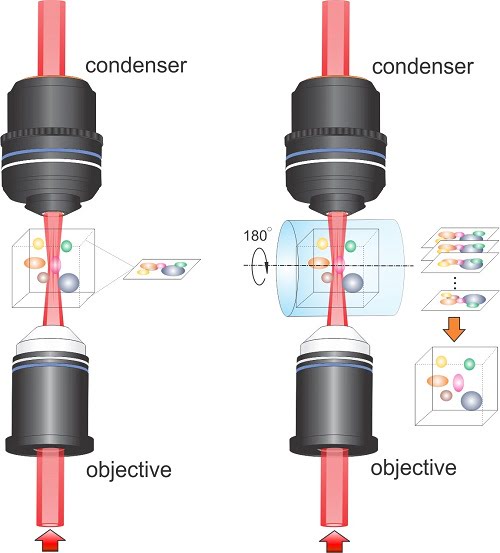Imagine blood tests without having to actually have blood drawn. Researchers from Purdue University have developed a chemical imaging system that uses an InSight DeepSee femtosecond laser to penetrate deep into tissue that could eliminate conventional blood tests for analyses such as drug testing and early detection of diseases.

This schematic depicts an imaging system that uses a special type of laser beam called a Bessel beam that is produced using a pair of cone-shaped “axicon” lenses combined with a microscope objective. Purdue University researchers are using the system, which is able to penetrate deep into tissue and might lead to technologies that eliminate the need to draw blood for analyses including drug testing and early detection of diseases such as cancer and diabetes. Courtesy of Purdue University / Ji-Xin Cheng.
The laser system has two 100-fs pulses — one at 1040 nm with the other tunable from 680 to 1300 nm — giving the user the ability to tune the laser to excite different vibrational transitions of the specimen.
Chi Zhang, a postdoctoral research associate at Purdue’s Weldon School of Biomedical Engineering, told Photonics Media that their stimulated Raman projection microscopy and tomography system works with stimulated Raman spectroscopy (SRS) and produces high speed volumetric imaging of chemical compositions in a 3D sample without labeling.
“Current fluorescence techniques rely on labeling, which could hamper the biological functionality of living samples, said Zhang. “In our method, we excite molecular vibrations, which act as fingerprints to identify different molecules in a label free manner.”
The Purdue system uses a type of laser beam called a Bessel beam, which can remain tightly focused over a longer distance than a traditional Gaussian beam used in other imaging technologies. It is produced using a pair of cone-shaped axicon lenses and is combined with a microscope objective. This is what gives the stimulated Raman projection microscopy and tomography system the ability to penetrate deep into tissue, potentially leading to future systems that eliminate the need to draw blood.
“To deconvolute the spatial distribution of the chemicals in the volume, we rotated the sample and reconstructed the 3D image using a tomographic way, said Zhang. “This is the first SRS based tomography imaging ever reported. It allows high speed quantification of chemical information in a 3D volume.”
The researchers proved the concept by imaging fat storage in living cells.
Ji-Xin Cheng, a professor in Purdue University’s Weldon School of Biomedical Engineering, Department of Chemistry and Birck Nanotechnology Center, said there is still more work to be done and there is plenty of room for improvement.
“The system is based on a bulky and relatively expensive femtosecond laser, which limits its potential for broad use and clinical translation, said Cheng. “Nevertheless, we anticipate that this limitation can be circumvented through engineering innovations to reduce the cost and size of our technology. We also note that the Bessel beam can be produced using fibers, which could simplify the system and enable endoscopic applications.”
Future research will include work to increase the detection sensitivity of the system and improve the imaging quality and speed. Zhang also said the new technology can be used to “quantify lipid accumulation in a tissue biopsy” potentially helping with the early diagnosis of cancers.
The Purdue research has been published in the journal Nature Communications (doi:10.1038/ncomms15117).